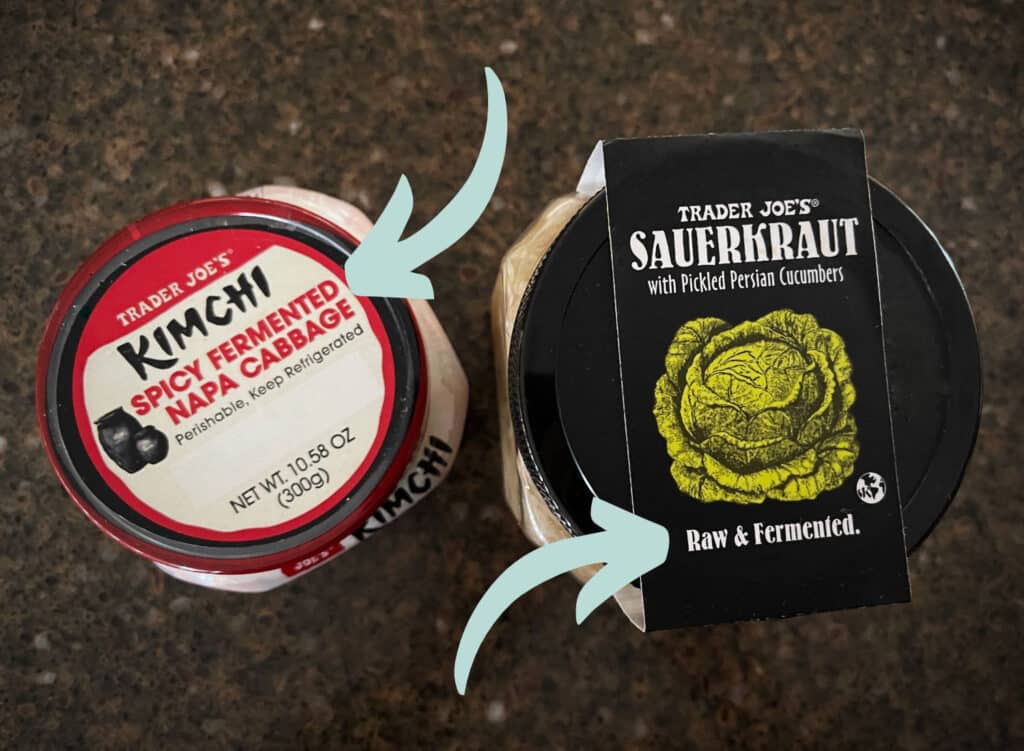We came home from the 2022 Wise Traditions conference energized and jazzed to start GAPS right away. I got a reality check, though, when I realized that Thanksgiving was only a few weeks away. And then Christmas. And our annual neighborhood New Year’s Eve party…
If we’d already been doing GAPS for awhile and were already accustomed to it, then sure, it might have been fine. But it felt kinda masochistic to start GAPS cold turkey in the middle of the holidays if we didn’t have to. So we settled on January as a more realistic time to begin. In the 2-3 months leading up to our GAPS start date, I read as much about the diet as I could, started collecting recipes and made a whole lot of lists.
I figured there was no reason why we couldn’t start practicing parts of the protocol, so I began implementing facets of the GAPS Diet — starting with a bit of fermented *something* at every meal and a mug of broth with most meals and as a snack during the day.
Easing into GAPS
In retrospect, I think think it’s absolutely essential to spend at least a few weeks preparing and planning like this. Read Dr. Campbell-McBride’s book. Read other books and blogs written by people who have already navigated through GAPS. Get yourself a cookbook or three and make a list of recipes that will work for your family.
Over the course of my research, I read several articles suggesting various ways to make easing into GAPS as comfortable as possible by removing one non-GAPS food at a time. I like this idea. Instead of a bunch of major changes at once, you only have to deal with one at a time. Get accustomed to it and move to the next.
I took a slightly different approach.
Instead of removing things from our diet, I eased us into GAPS by focusing on adding things we would need to become accustomed to eating. Fermented foods. Homemade raw-milk yogurt, sauerkraut, fermented beets and carrots, mugs of homemade meat stock, snacks made with dates and honey, etc. This served the duel purpose of helping ME to get used to preparing these foods plus, I reasoned, the addition of these foods might naturally start displacing things that we’d eventually need to give up for GAPS anyway…
It worked. Without really trying, we cut way back on things like bread, starch and sweets in favor of the broth, fermented foods and GAPS-legal treats.
And most importantly, I got lots of low-pressure practice making these foods, and sorting out how I would fit their preparation into my daily routine.
Practice makes perfect
There’s no sugarcoating it; GAPS can be pretty darn time consuming and it’s a lot of pressure on the primary preparer of food. There’s really no getting around that. You can plan ahead and do large batch cooking to make things easier on yourself, but if you’re used to relying on processed convenience foods — or even less processed, store-bought staples such as broth, yogurt, sour cream and sauerkraut — it will be an adjustment as you shift to making homemade versions of these yourself.
For example, it had been quite awhile since I’d made homemade raw milk yogurt, and I needed to acquaint myself with the 24-hour version recommended for GAPS. Disaccharides such as lactose, sucrose and maltose (from starch) are difficult to digest and may contribute to digestive problems in those with abnormal gut flora, so they are omitted for the duration of the GAPS protocol. The 24-hour yogurt ensures that virtually all of the lactose is fermented out of the yogurt.
The extra-long ferment time also creates a more potent probiotic than what you’d get from the store. Typically, store-bought yogurt is fermented for a brief period at a higher temperature, and then it may be flash-pasteurized to extend its shelf life. Unfortunately, this means that many store-bought yogurts contain very few live cultures by the time they make it to your table.
Homemade yogurt also objectively tastes better than store bought.
Mr Redheaded Herbalist is a bit of an ice cream connoisseur, and even he conceded that as long as he can have a little bit of homemade yogurt mixed with a bit of honey and a few berries, he won’t miss his beloved ice cream (much).

Failing to plan = planning to fail
The #1 secret to GAPS success is getting organized. It’s imperative to have your kitchen stocked and ready before you go all in.
Planning and preparing meals and snacks in advance will save your sanity and help to make the coming weeks/months/years more manageable. GAPS requires strict adherence to the dietary protocol, so it’s important to be organized and prepared to anticipate pitfalls and temptations that could derail your progress.
- Make sure you have a good source of quality, organic pastured meats (fresh or frozen) and plenty of meat bones and chicken feet for making broth.
- Find a good source for quality, organic pastured eggs and lay in a good supply. After they’re reintroduced in Intro Stage 2 and 3, you’ll be going through quite a few eggs and egg yolks every week.
- Source quality, organic pastured animal fats such as tallow, duck or goose fat, ghee and lard.
- Purchase a supply of high-quality mineral salt and organic peppercorns, upon which you will rely heavily until other spices are reintroduced in GAPS Intro Stage 6.
- If Candida overgrowth isn’t an issue, stock up on local-to-you raw honey.
- Make sure that you have the necessary kitchen tools and equipment. A slow cooker or pressure cooker, a food processor and a good blender will make the transition to the diet as smooth as possible.
- Clean junk food and anything you won’t be eating on GAPS out of your pantry so no one is tempted by the graham crackers or leftover Christmas candy canes.
- Replace the sugar bin with honey, dates and date sugar.
- Make a large batch of sauerkraut and other fermented veggies ahead of time.
- Make a big batch of crispy nuts ahead of time — and maybe some Intro Diet-legal coconut creams (from The Heal Your Gut Cookbook) so they’re ready to grab and go when snack cravings arise.
- Make sure you’re comfortable making meat stock using whatever method is easiest for you. Make an extra batch of meat stock in advance and freeze it for later.
- Learn to cook in large batches and freeze for later. Pick a couple of simple soup recipes appropriate for Intro Stages and make them ahead of time too. (Believe me, frozen soup will feel like a godsend on busy nights when you didn’t have time to plan dinner!)
- Get yourself some 2-cup silicone molds and freeze individual sized portions of soup for quick meals. This idea came from a good friend whose family is also starting GAPS, including her mother and 3 young boys. (Thank you Lynn! ♥)
- If you’re doing dairy, get familiar with making 24-hour homemade yogurt and crème fraîche. Purchase any starter cultures you might need. It’s also very handy to have nutmilk bags or a strainer for dripping your yogurt to thicken it. These strainers easily handle a half gallon-sized batch of yogurt.
- If you’ll be using probiotic beverages like kombucha or water kefir once they’re introduced in Intro Stage 6, source a SCOBY and/or kefir grains and practice making it ahead of time.
- Start weaning yourself off any addictive foods or beverages (such as caffeinated beverages, alcohol and sugar) that may cause discomfort if stopped cold turkey.
- If you’re a coffee drinker, consider weaning off your morning coffee a couple months in advance. Start by replacing half of your regular coffee with herbal coffee or a high-quality Swiss water process decaf and work up to full decaf/herbal. No sense in adding a caffeine withdrawl headache to the mix when you begin GAPS!
- Same story if you’re accustomed to an evening ‘adult’ beverage. Start cutting back on alcohol in general, and look for enjoyable replacements for your evening routine. For example, I’ve learned to enjoy a glass of sparkling mineral water with a spoonful of oxymel and a few dashes of bitters added. It’s especially satisfying if I drink it out of a fancy glass. 😉

Smart shortcuts FTW
There’s so much food prep required by GAPS, don’t be shy about turning to shortcuts if they make sense and don’t sacrifice quality.
Part of our preps to start GAPS included ordering 20-lb boxes of frozen organic cubed butternut squash, frozen organic cubed carrots and frozen organic diced beets from Azure Standard. (Handy that we’re starting in the middle of winter and my porch can serve as an extra walk-in freezer!)
Pick your battles. It will be significantly more expensive than fermenting your own sauerkraut, but if you truly can’t find the time to do it, source a case of raw, fermented sauerkraut from a place like Azure Standard or your local health food store. Just make certain it is a live fermented sauerkraut and not just “pickled” in vinegar.

Invest in an extra slow cooker and dedicate it to a perpetual meat stock. Broth is the foundation of the GAPS diet. You will go through a lot of it. Having a warm slow cooker full of broth ensures you always have enough on hand. Simply make meat stock as described by the GAPS protocol and when it’s done, strain out the meat (use it for dinner or freeze for later) and return the stock to the slow cooker. Keep a ladle nearby to make accessing the broth fast and easy. When it runs low, transfer the last bit to the refrigerator and start again.
Larabars are another common GAPS “mini-cheat.” Larabars typically only contain a few ingredients — dates, nuts and maybe some coconut or dried fruit. Their only drawback is they’re not organic and the nuts are not soaked. Sometimes it’s not worth letting perfect be the enemy of good. In a pinch, they’re a mighty convenient concession to appease hungry kiddos on the road or a hangry adult who worked through lunch. ♥

More on GAPS, GAPS-friendly recipes & preparing for GAPS:
Tips & Tricks For Doing GAPS With Kids
Wise Traditions & Homemade Sauerkraut
Quick Fermented Garlicky Beets
Water Kefir SOS: Troubleshooting Your Brew
The Health Benefits Of Soaking Nuts & Seeds
Simple Larabar Inspired Date Bars Using Soaked Nuts



